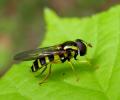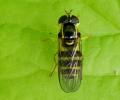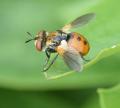|
two Nematocera
|
|
| Nikita Vikhrev |
Posted on 02-10-2005 10:03
|
|
Member Location: Posts: 9193 Joined: 24.05.05 |
30 sept, Moscow region. First one looks like new family for me, Sciaridae: ant - 16, wings longer abdomen, costa ending on wing top, venation on forepart of wing more visible, one only cross vein (Rs by Bey-Bienko, r-m (?) by Menzel). Second - Ceratopogonidae, short forelegs, ant -7. Am I right?  
Nikita Vikhrev - Zool Museum of Moscow University |
|
|
|
| Jan Willem |
Posted on 02-10-2005 16:13
|
|
Member Location: Posts: 2122 Joined: 24.07.04 |
Hi Nikita, I have my doubt about the identification of the second one, but the first one is indeed a Sciaridae! Jan Willem |
|
|
|
| Paul Beuk |
Posted on 02-10-2005 21:16
|
|
Super Administrator Location: Posts: 19208 Joined: 11.05.04 |
The second is Chironomidae, possibly one of the species with terrestrial larvae.
Paul - - - - Paul Beuk on https://diptera.info |
|
|
|
| Nikita Vikhrev |
Posted on 02-10-2005 22:05
|
|
Member Location: Posts: 9193 Joined: 24.05.05 |
Thank you Jan and Paul. I excluded Chironomidae because of nonplumose antenae... Nikita Vikhrev - Zool Museum of Moscow University |
|
|
|
| Paul Beuk |
Posted on 03-10-2005 07:52
|
|
Super Administrator Location: Posts: 19208 Joined: 11.05.04 |
Usually it is the males who have plumose antennae. Especially in the ones with terrestrial larvae, the male antennae may be less densly plumose.
Paul - - - - Paul Beuk on https://diptera.info |
|
|
|
| Jump to Forum: |














 but don't see the image in the post.
but don't see the image in the post.
